Trees Birds Mammals Fish Amphibians Reptiles
Wild Algarve
Bookshop
Laccaria laccata (Scop.) Cooke - Deceiver
Phylum: Basidiomycota - Class: Agaricomycetes - Order: Agaricales - Family: Hydnangiaceae
Distribution - Taxonomic History - Etymology - Identification - Culinary Notes - Reference Sources

Laccaria laccata is a very common woodland
fungus, and where you find one you are likely to find many more. Deceivers are mycorrhizal fungi. The
cap colour changes quite significantly with age and depends also on the weather, and this characteristic is the origin of the common name..
Distribution
Abundant in all kinds of woodland in Britain and Ireland, Laccaria laccata occurs also throughout mainland Europe and in North America.
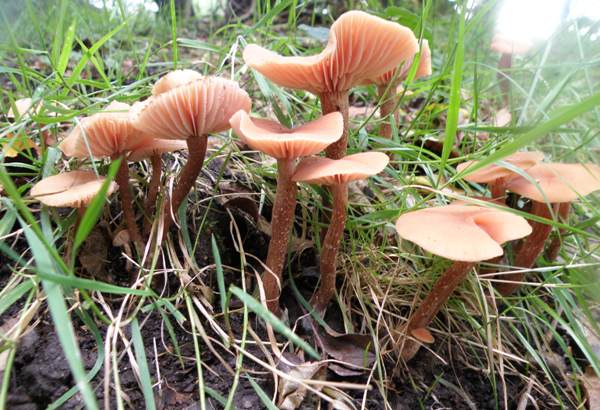
Taxonomic history
Austrian mycologist Giovanni Antonio Scopoli described this woodland mushroom in 1772, naming it Agaricus laccatus. (In the early days of fungal taxonomy most gilled mushrooms were placed in one gigantic Agaricus grouping, which has since been broken up into many other genera, leaving in the Agaricus genus a relatively small group of the 'true mushrooms', as they are sometimes called.) It was the British mycologist Mordecai Cubitt Cooke who moved this species into its present genus in 1884, at which time the specific epithet was changed to laccata.
Laccaria laccata has a vast array of synonyms including Agaricus laccatus Scop., Agaricus incanus Bull., Agaricus farinaceus Huds., Agaricus rosellus Batsch, Clitocybe laccata (Scop.) P. Kumm., Laccaria affinis (Singer) Bon, and Laccaria scotica (Singer) Contu.
Laccaria laccata is the type species of the Laccaria genus.
Etymology
The generic name Laccaria translates to 'lacquer' (shiny paint), and the specific epithet laccata means varnished or coated with lacquer. That's what I call toadstool tautology, or to put it another way... on second thoughts perhaps not, as to do so would be tautologous!
Identification guide
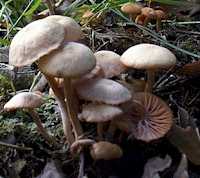 |
Commonly (and most aptly) known as Deceiver, this very
variable mushroom is not always easy to identify with certainty. The broad
gills and fibrous hollowing stems are helpful characteristics, but cap
size, shape and colour are very little help because they come in so many
varieties. Often, however, you will find brown, tan and almost white caps
together - as in the two groups illustrated here (darker caps in the
distance). |
 |
Cap
2 to 7cm in diameter, the caps of Laccaria laccata are initially convex and become almost
flat-topped at maturity.
During wet weather young caps of a Deceiver are deep tan
or reddish-brown (sometimes as the specimen seen here, but often much more
orange). |
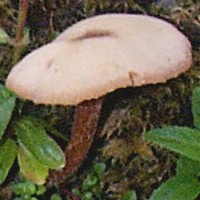 |
During dry spells the caps and stems become much
paler buff and eventually almost white. Very old Deceivers sometimes become
funnel-shaped and very distorted. |
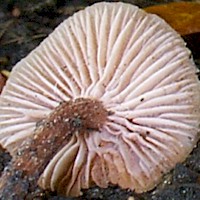 |
Gills
The broad, deep gills of the Deceiver are widely spaced and
interspersed with shorter gills. Long before the cap fades to buff, the
tan gills begin losing their colour. This is because they get covered in
spores and - perhaps surprisingly
when you see how dark the young gills are - the spores of this mushroom
are white.
Stem
6 to 10mm in diameter and 5 to 10cm tall,
the tough, fibrous stems are increasingly more 'hairy' towards the base. |
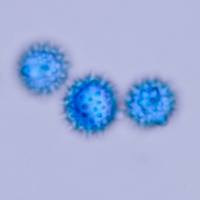 |
Spores
Globose, 7-10μm diameter, with spines up to 1.5μm tall.
Spore print
White. |
Odour/taste |
Not distinctive. |
Habitat & Ecological role |
Among leaf litter in all kinds of mixed woodland
and on heaths. Laccaria laccata is ectomycorrhizal with various broadleaf and coniferous trees including pines (family Pinaceae), beech and occasionally oaks (Fagaceae) and birches (Betulaceae). |
Season |
June to November in Britain and Ireland; later in the year in southern Europe. |
Similar species |
Laccaria amethystina is a violet coloured member of the same
genus; once it has dried out it becomes pale buff and virtually
indistinguishable from Laccaria laccata.
Laccaria bicolor is distinguished by its stem, which has a lilac base and a tawny upper section.
Laccaria proxima is similar but has a scurfy cap and ellipsoidal spores.
Laccaria tortilis is a tiny deceiver with a contorted cap.
|

Culinary Notes
The Deceiver Laccaria laccata is an edible mushroom, and although perhaps not one of Mother Nature's finest offerings the caps are very good when fried, tasting rather like shop-bought button mushrooms (Agaricus bisporus). Deceivers are also fine when used to make mushroom soup. The tough fibrous stems are best discarded.
Reference Sources
Fascinated by Fungi, 2nd Edition, Pat O'Reilly 2016, reprinted by Coch-y-bonddu Books in 2022.
Giovanni Antonio Scopoli (1772). Flora Carniolica (2nd ed.). p.444.
Dictionary of the Fungi; Paul M. Kirk, Paul F. Cannon, David W. Minter and J. A. Stalpers; CABI, 2008
Taxonomic history and synonym information on these pages is drawn from many sources but in particular from the British Mycological Society's GB Checklist of Fungi.
Acknowledgements
This page includes pictures kindly contributed by David Kelly.
Top of page...
Fascinated by Fungi. Back by popular demand, Pat O'Reilly's best-selling 450-page hardback book is available now. The latest second edition was republished with a sparkling new cover design in September 2022 by Coch-y-Bonddu Books. Full details and copies are available from the publisher's online bookshop...